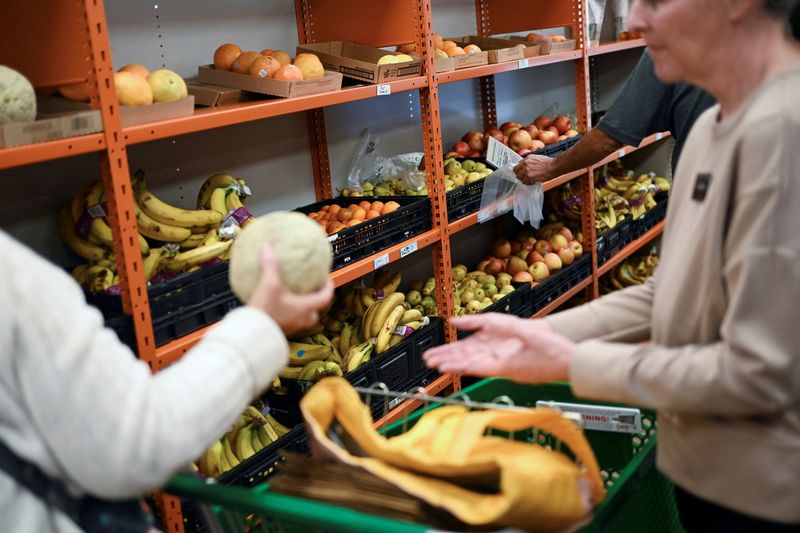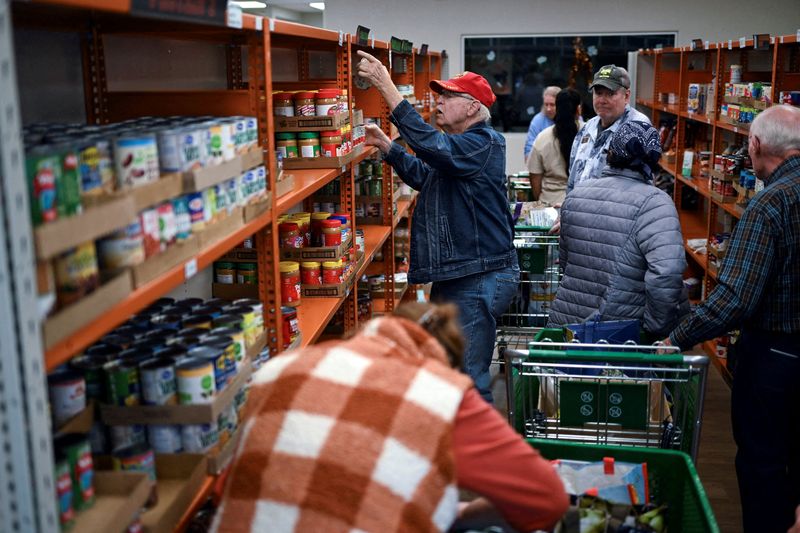By Bo Erickson and Leah Douglas
WASHINGTON (Reuters) -Nearly 42 million people are set to lose food aid due to the second-longest U.S. government shutdown, as Democrats and Republicans in Congress continue to blame each other for a weeks-long legislative stalemate.
Neither party was showing signs of changing its position days before funding for the Supplemental Nutrition Assistance Program, also known as food stamps, is set to lapse beginning on Saturday.
The U.S. Department of Agriculture’s decision last week not to draw on an emergency fund to pay for part of November’s SNAP benefits is splitting senators, as Democrats argue the agency is legally required to spend the roughly $5.5 billion in contingency funds to maintain at least a portion of the benefits.
“The Trump administration is weaponizing hunger as a political bargaining chip,” said Senator Jeanne Shaheen of New Hampshire, the top Democrat overseeing food aid funding. “When it comes down to it, this is a choice.”
Republicans say Senate Democrats are responsible for the shutdown because most have voted 13 times against a stopgap bill to reopen government, called a “CR” or continuing resolution, to force concessions from the Republican majority on healthcare issues.
“The Democrats should vote for a clean CR to open government, and that’ll take care of all these things,” said Senator John Hoeven of North Dakota, the top Republican in charge of food aid appropriations.
The White House’s Office of Management and Budget did not respond to a request for comment.
CUTS TO A BIPARTISAN PROGRAM
The cost and breadth of U.S. food support is regularly debated in Congress, especially during renegotiation of the farm spending bill that funds SNAP.
Trump and Republicans’ July tax and spending bill expanded SNAP work requirements and increased state-specific costs. This has limited almost $200 billion in overall funding and could push some off the program.
Americans in every state rely on the federal benefits. Of the top five states with the highest per capita SNAP beneficiaries, who represent more than 15% of the population, three are represented by Republican senators: Louisiana, Oklahoma and West Virginia.
This week, Republican Senator Josh Hawley pushed a standalone bill to fund SNAP in November, which garnered some bipartisan co-sponsors by Tuesday, followed by Senate Democratic leaders announcing their own version. However, Republican Senate Majority Leader John Thune questioned why the chamber should vote on such a bill after a similar targeted bill to pay federal workers during the shutdown failed last week.
LEGAL U-TURN AT THE USDA
SNAP benefits have been distributed in past shutdowns, including the longest in history during Trump’s first term.
At the time, Trump’s USDA officials argued to Congress’ nonpartisan watchdog, the Government Accountability Office, that contingency funds could be used for benefits.
The agency repeated that position in a September 30 plan, released by the USDA in advance of the current shutdown, but that plan was no longer visible on the USDA website. Instead, a website banner blames Democrats for failing to fund SNAP at the expense of backing healthcare for immigrants living in the U.S. illegally and “gender mutilation procedures.”
“That’s just a red herring,” said Senator Tina Smith, a Minnesota Democrat, about the department’s message. “They’re using people who need SNAP to put food on the table as a bargaining chip, and that’s just terrible.”
On the merits of the department’s argument, Senator Susan Collins, the Republican chair of the appropriations committee, told reporters she believes the USDA’s “novel interpretation” of the spending law was forced by the Office of Management and Budget.
The USDA said in a memo the contingency fund is meant for unplanned expenses like natural disasters. But on Tuesday, Agriculture Secretary Brooke Rollins noted the open debate.
“We can talk legalistics, and is it legal, and can we move this money, and is that $5 billion available, and is it not,” Rollins said on CNN, “But all it takes is a ‘yes’ on a continuing resolution to keep the government going.”
Cindy Long, national adviser at professional services firm Manatt and 30-year USDA veteran who helped lead nutrition programs, said the agency in the past had routinely planned to draw on the contingency funds for benefits if needed.
Attorneys general and governors from 25 Democratic-led states sued the USDA on Tuesday to issue SNAP benefits.
“The Trump administration has been taking away both sides of the power of the purse,” said Georgetown University law professor David Super, an appropriations expert. “They’ve been refusing to spend money Congress has directed them to spend, and they’ve been spending money without any appropriation.”
(Reporting by Bo Erickson and Leah Douglas in Washington; additional reporting by David Morgan and Christian Martinez; editing by Scott Malone and Richard Chang)



